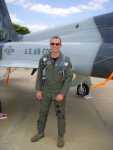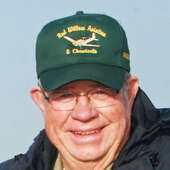- Sweatshirts, Jazzercise, and an unforgiving political climate (11/19/24)
- After the election: Lessons from history (11/5/24)
- Candy or cash: candidates and causes trick-or-treat for donations (10/29/24)
- You are fired! (10/1/24)
- Enduring heritage: Model T’s and Nebraska’s Unicam (9/24/24)
- YMCA project, coming changes and another attack (9/17/24)
- Class of '55 to share memories for Heritage Days (9/10/24)
Opinion
'Good enough'
Tuesday, June 22, 2010

Trevor Evans with his beloved T-38. (Courtesy photo)
"Good enough."
Those were the words spoken by the 2nd Lieutenant as I congratulated him on being assigned to fly C-17 cargo aircraft. "Good enough‚" but I could see the disappointment on his face betraying his inward disappointment at not getting an A-10 or reconnaissance C-12 or about anything more exciting than flying a big ole cargo hauler. He may have been disappointed but I was overjoyed as I know in my heart that he will grow to love the assignment.
Last Friday was "assignment day" for the class of students nearing their near-two-year long stint of Air Force pilot training at Vance Air Force Base near Enid, Oklahoma. All looked to assignment day with trepidation as their first operational assignment will have great affect on the direction their career will take. Assignments are handed out strictly as per the needs of the Air Force, but class standing based on grades earned throughout the course and the "wish list" submitted by each student are also (sometimes) taken into consideration. Most students have a desire to fly the fast movers, the best and the latest jet fighter aircraft. Nowadays, though the threat of being last in your class and being assigned to remotely piloted aircraft (RPV), better known at drones, keeps the student's noses to the grindstone.
Assignment day is big so I loaded Trevor's mom, uncle and granddad into my airplane and flew to Enid to participate in the event. Trevor is McCook High, farm kid, University of Nebraska graduate, 2nd Lt. U.S. Air Force Trevor Evans. I had the privilege of teaching the lieutenant to fly light aircraft right here at the McCook Municipal (note the name) Airport but completing the Air Force training is like earning a PhD in Aviation. Supersonic, acrobatics, all-weather instruments, close formation flying, he can now do it all! He and his pilot training classmates cause this old tanker pilot to pop the buttons on my shirt as my chest swells with pride. They truly are the best of the best!
The role of the cargo pilot in today's Air Force is perhaps not the sexiest vision for these graduating young bucks with their hair on fire and eager to go out and tame the world. But as I told Trevor, the C-17 is the newest of our country's large aircraft and they are still making them today. It has the HUD, a glass cockpit, and probably is much better equipped electronically than the best airliners flying today.
The C-17, nicknamed the Globemaster III, is in a word huge. Empty it weighs nearly 140 tons. Powered by four turbofan engines each putting out 40,400 pounds of thrust (roughly 40,000 horsepower each) the airplane can load 100 tons of cargo plus 50,000 gallons of fuel onboard and fly 3,000 miles non-stop. It is capable of refueling from tankers while airborne, so its actual range is limited only by the endurance of the three crewmembers, two pilots and one loadmaster, who make it happen.
Need a critical part for a combat aircraft 10,000 miles away? The C-17 can make it happen in 20 hours elapsed time. Want to deliver a tank to the battlefield? The Globemaster can haul them two at a time. Fifteen of the aircraft flying in tight formation can drop a whole US Army Brigade of paratroopers, equipment and all, as they did in northern Iraq in 2003. Fly combat wounded from Afghanistan back to the States in 12 hours; simply outfit the bird with a hospital kit, complete with flight nurses, point the nose west and make it happen. The Air Force has about 200 of those wondrous aircraft and probably half a dozen are airborne somewhere in the world even as you read this.
The lieutenant has to do seven more flights in the T-38 before he is awarded his wings. Then it is off to a grueling two-week Air Force survival school complete with prisoner of war treatment. He will also go to the C-17 schoolhouse in Altus, Oklahoma, before reporting to his first base Dover AFB, Delaware USofA. In a few short months, step outside, look up and possibly you can spot him overhead practicing air-refueling from a KC-135 on the track that goes right over McCook, Nebraska.
Yes I envy Lt. Evans his future. The world will be his oyster. In due time he will fly over the North Pole, the South Pole and about every friendly country between, landing in most. He will make it completely around the world more than once and see things that you and I can only dream.
He may be a little disappointed now, but I am sure that he will grow to love the role. I see it as a fantastic opportunity and they will even pay him to do it! How could life be any better?
That is the way I saw it.

